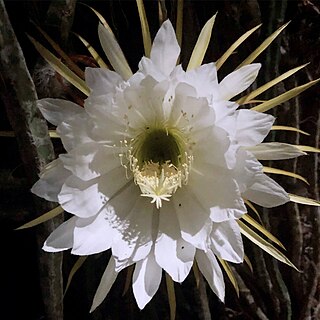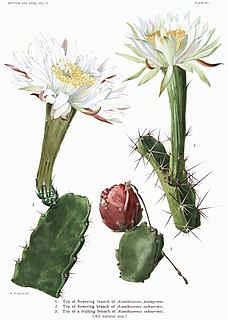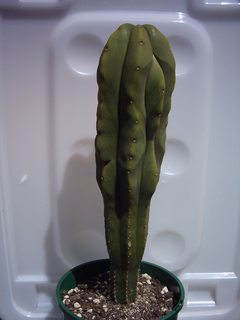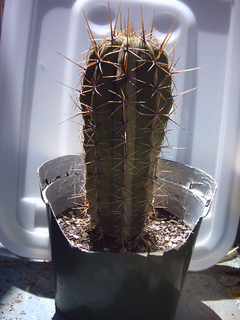
A cactus is a member of the plant family Cactaceae, a family comprising about 127 genera with some 1750 known species of the order Caryophyllales. The word cactus derives, through Latin, from the Ancient Greek word κάκτος (káktos), a name originally used by Theophrastus for a spiny plant whose identity is now not certain. Cacti occur in a wide range of shapes and sizes. Although some species live in quite humid environments, most cacti live in habitats subject to at least some drought. Many live in extremely dry environments, even being found in the Atacama Desert, one of the driest places on Earth. Because of this, cacti show many adaptations to conserve water. For example, almost all cacti are succulents, meaning they have thickened, fleshy parts adapted to store water. Unlike many other succulents, the stem is the only part of most cacti where this vital process takes place. Most species of cacti have lost true leaves, retaining only spines, which are highly modified leaves. As well as defending against herbivores, spines help prevent water loss by reducing air flow close to the cactus and providing some shade. In the absence of true leaves, cacti's enlarged stems carry out photosynthesis. Cacti are native to the Americas, ranging from Patagonia in the south to parts of western Canada in the north—except for Rhipsalis baccifera, which also grows in Africa and Sri Lanka.

Night-blooming cereus is the common name referring to a large number of flowering ceroid cacti that bloom at night. The flowers are short lived, and some of these species, such as Selenicereus grandiflorus, bloom only once a year, for a single night. Other names for one or more cacti with this habit are princess of the night, Honolulu queen, Christ in the manger, dama de noche and queen of the night.

Acanthocereus is a genus of cacti. Its species take the form of shrubs with arching or climbing stems up to several meters in height. The generic name is derived from the Greek word άκανθα (acantha), meaning spine, and the Latin word cereus, meaning candle. The genus is native to the mostly tropical Americas from Texas and the southern tip of Florida to the northern part of South America, including islands of the Caribbean.

Echinopsis is a large genus of cacti native to South America, sometimes known as hedgehog cactus, sea-urchin cactus or Easter lily cactus. One small species, E. chamaecereus, is known as the peanut cactus. The 128 species range from large and treelike types to small globose cacti. The name derives from echinos hedgehog or sea urchin, and opsis appearance, a reference to these plants' dense coverings of spines.

Bergerocactus emoryi is a species of cactus, known commonly as the golden-spined cereus, golden snake cactus, velvet cactus or golden club cactus. It is a relatively small cactus, but it can form dense thickets or colonies, with the dense yellow spines giving off a velvety appearance when backlit by the sun. From April to May, yellow, green-tinged flowers emerge, which transform into reddish, globular fruit. This species is native to the California Floristic Province, and is found in northwestern Baja California and a small part of California, in San Diego County and on the southern Channel Islands. Where the Mediterranean climate of the California Floristic Province collides with the subtropical Sonoran Desert near El Rosario, hybrids with two other species of cacti are found. It is the sole member of the monotypic genus Bergerocactus, named after German botanist Alwin Berger.

Echinopsis peruviana, the Peruvian torch cactus, is a fast-growing columnar cactus native to the western slope of the Andes in Peru, between about 2,000–3,000 m (6,600–9,800 ft) above sea level.

The term ceroid cactus is used to describe any of the species of cacti with very elongated bodies, including columnar growth cacti and epiphytic cacti. The name is from the Latin cēreus, wax taper, referring to the stiff, upright form of the columnar species. Some species of ceroid cacti were known as torch cactus or torch-thistle, supposedly due to their use as torches by Native Americans in the past.

Echinopsis lageniformis, the Bolivian torch cactus, is a fast-growing columnar cactus from the high deserts of Bolivia. Among the indigenous populations of Bolivia, it is sometimes called achuma or wachuma, although these names are also applied to related species such as Echinopsis pachanoi which are also used for their psychedelic effects.

Echinopsis scopulicola is a type of cactus native to Bolivia, which contains psychedelic compounds. Many claimed this species contained mescaline. This was confirmed in 2010 in a study of well-documented individual living plants of the subgenus Trichocereus of the genus Echinopsis. E. scopulicola was noted to contain 0.82% mescaline by dry weight in the outer green layer.

Echinopsis macrogona, syn. Trichocereus macrogonus, is a species of cactus found in Bolivia.

Echinopsis pachanoi — known as San Pedro cactus — is a fast-growing columnar cactus native to the Andes Mountains at 2,000–3,000 m (6,600–9,800 ft) in altitude. It is found in Argentina, Bolivia, Colombia, Chile, Ecuador and Peru, and it is cultivated in other parts of the world. Uses for it include traditional medicine and traditional veterinary medicine, and it is widely grown as an ornamental cactus. It has been used for healing and religious divination in the Andes Mountains region for over 3,000 years. It is sometimes confused with its close relative Echinopsis peruviana.

The Huntington Desert Garden is part of The Huntington Library, Art Collections and Botanical Gardens in San Marino, California. The Desert Garden is one of the world's largest and oldest collections of cacti, succulents and other desert plants, collected from throughout the world. It contains plants from extreme environments, many of which were acquired by Henry E. Huntington and William Hertrich in trips taken to several countries in North, Central and South America. One of the Huntington's most botanically important gardens, the Desert Garden brought together a group of plants largely unknown and unappreciated in the beginning of the 1900s. Containing a broad category of xerophytes, the Desert Garden grew to preeminence and remains today among the world's finest, with more than 5,000 species in the 10 acre garden.

Lophocereus marginatus is a species of plant in the family Cactaceae. It is sometimes called Mexican fencepost cactus. It has columnar trunks that grow slowly to 12 feet and may reach 20 feet in height. Stems are 3 to 4 inches (9–10 cm) in diameter, with ribs 5 to 7 in (13–18 cm). Its central spine is about 3/8 inch (1 cm) in diameter with five to 9 radials and slightly yellowish in color. Its cuttings are sometimes used to create fences, as its spines are not as large or dangerous as some cacti.

Cereus is a genus of cacti including around 33 species of large columnar cacti from South America. The name is derived from Greek (κηρός) and Latin words meaning "wax", "torch" or "candle". The genus Cereus was one of the first cactus genera to be described; the circumscription varies depending on the authority. The term "cereus" is also sometimes used for a ceroid cactus, any cactus with a very elongated body, including columnar growth cacti and epiphytic cacti.

Echinopsis mamillosa is a species of cactus from Bolivia.

Echinopsis candicans is a species of cactus from northern and western Argentina. It has large fragrant white flowers that open at night.

Echinopsis atacamensis (cardón) is a species of cactus from Chile, Argentina and Bolivia. The wood of this species can be used in building and in making furniture.

Browningia candelaris is a species of cactus from northern Chile and southern Peru. It has a distinctive growth habit, with a straight spiny trunk topped by more-or-less spineless thinner branches. In some places, the long-term survival of local populations may be threatened by grazing, which destroys seedlings.

Pachycereus pecten-aboriginum is a columnar cactus plant native to Mexico. They can grow up to 15 m (49 ft) high. The trunk of this species is 1.2 to 5.0 m tall and the fruits are large and burr-like. The specific name, pecten-aboriginum, is from the Latin, and means "native combs". It was inspired by the use of the fruits as hair combs.

Echinopsis terscheckii, commonly known as the cardon grande cactus or Argentine saguaro, is a large cactus native to South America and popular in cultivation.




















